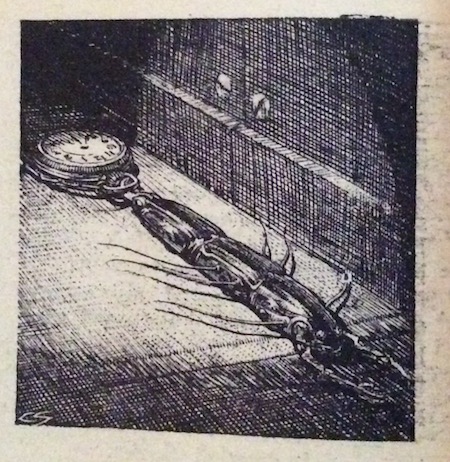Science Fiction
Dictionary
A B C D E F G H I J K L M N O P Q R S T U V W X Y Z
MicroTug Is A Micro Robot Beast

Take a look at this tiny (12 gram) micro robot dragging hundreds of times its own weight across a table. The µTug secret? (it's in the feet!)
(µTug or MicroTug robot video)
The controllable adhesives used by insects to both carry large loads and move quickly despite their small scale inspires the µTug robot concept. These are small robots that can both move quickly and use controllable adhesion to apply interaction forces many times their body weight. The adhesives enable these autonomous robots to accomplish this feat on a variety of common surfaces without complex infrastructure. The benefits, requirements, and theoretical efficiency of the adhesive in this application are discussed as well as the practical choices of actuator and robot working surface material selection. A robot actuated by piezoelectric bimorphs demonstrates fast walking with a no-load rate of 50 Hz and a loaded rate of 10 Hz. A 12 g shape memory alloy (SMA) actuated robot demonstrates the ability to load more of the adhesive enabling it to tow 6.5 kg on glass (or 500 times its body weight). Continuous rotation actuators (electromagnetic in this case) are demonstrated on another 12 g robot give it nearly unlimited work cycles through gearing. This leads to advantages in towing capacity (up to 22 kg or over 1800 times its body weight), step size, and efficiency. This work shows that using such an adhesive system enables small robots to provide truly human scale interaction forces, despite their size and mass. This will enable future microrobots to not only sense the state of the human environment in which they operate, but apply large enough forces to modify it in response.
Eric Frank Russel had a piece of this future in 1941. Writing in Astounding Stories as Maurice A. Hugi, he created a vision that inspired Ray Bradbury and many roboticists. Be sure to read more about his story The Mechanical Mice, but for now take a look at the golden shuttles:
... there came a very tiny, very subtle and extremely high-pitched whine. Something small, metallic, glittering had shot through one of the rat holes, fled across the floor toward the churning monstrosity. A trapdoor opened and swallowed it with such swiftness that it had disappeared before I realized what I'd seen. The thing had been a cylindrical, polished object resembling the shuttle of a sewing machine, but about four times the size. And it had been dragging something also small and metallic.

Read more at µTugs: Enabling Microrobots to Deliver Macro Forces with Controllable Adhesives and micro tugs.
Scroll down for more stories in the same category. (Story submitted 10/3/2016)
Follow this kind of news @Technovelgy.| Email | RSS | Blog It | Stumble | del.icio.us | Digg | Reddit |
Would
you like to contribute a story tip?
It's easy:
Get the URL of the story, and the related sf author, and add
it here.
Comment/Join discussion ( 0 )
Related News Stories - (" Robotics ")
Artificial Skin For Robots Is Coming Right Along
'... an elastic, tinted material that had all the feel and appearance of human flesh and epidermis.' - Harl Vincent (1934)
Robot Guard Dog On Duty
I might also be thinking of K-9 from Doctor Who.
Wearable Artificial Fabric Muscles
'It is remarkable that the long leverages of their machines are in most cases actuated by a sort of sham musculature...' HG Wells, 1898.
Dancing Robots Taught Dance Moves
'A clockwork figure would be the thing for you...' Jerome K. Jerome, 1893.
Technovelgy (that's tech-novel-gee!) is devoted to the creative science inventions and ideas of sf authors. Look for the Invention Category that interests you, the Glossary, the Invention Timeline, or see what's New.
Science Fiction
Timeline
1600-1899
1900-1939
1940's 1950's
1960's 1970's
1980's 1990's
2000's 2010's
Current News
The Zapata Air Scooter Would Be Great In A Science Fiction Story
'Betty's slapdash style.'
Thermostabilized Wet Meat Product (NASA Prototype)
There are no orbiting Michelin stars. Yet.
Could Crystal Batteries Generate Power For Centuries?
'Power could be compressed thus into an inch-square cube of what looked like blue-white ice'
India Ponders Always-On Smartphone Location Tracking
'It is necessary... for your own protection.'
Amazon Will Send You Heinlein's Knockdown Cabin
'It's so light that you can set it up in five minutes by yourself...'
Is It Time To Forbid Human Driving?
'Heavy penalties... were to be applied to any one found driving manually-controlled machines.'
Replace The Smartphone With A Connected Edge Node For AI Inference
'Buy a Little Dingbat... electropen, wrist watch, pocketphone, pocket radio, billfold ... all in one.'
Artificial Skin For Robots Is Coming Right Along
'... an elastic, tinted material that had all the feel and appearance of human flesh and epidermis.'
Robot Guard Dog On Duty
I might also be thinking of K-9 from Doctor Who.
Wearable Artificial Fabric Muscles
'It is remarkable that the long leverages of their machines are in most cases actuated by a sort of sham musculature...'
BrainBridge Concept Transplant Of Human Head Proposed
'Briquets head seemed to think that to find and attach a new body to her head was as easy as to fit and sew a new dress.'
Google's Nano Banana Pro Presents Handwritten Math Solutions
'...copy was turned out in a charming and entirely feminine handwriting.'
Edible Meat-Like Fungus Like Barbara Hambly's Slunch?
'It was almost unheard of for slunch to spread that fast...'
Sunday Robotics 'Memo' Bot Has Unique Training Glove
'He then started hand movements of definite pattern...'
Woman Marries Computer, Vonnegut's Dream Comes True
'Men are made of protoplasm... Lasts forever.'
Natural Gait With Prosthetic Connected To Nervous System
'The leg was to function, in a way, as a servo-mechanism operated by Larrys brain...'
